Finance and Accounting: Ratio Analysis, Investment Appraisal, Usefulness of Financial Statements
VerifiedAdded on 2023/01/11
|11
|2703
|66
AI Summary
This document explores the concepts of ratio analysis, investment appraisal, and the usefulness of financial statements in finance and accounting. It discusses profitability ratios, liquidity ratios, and the purpose of financial statements. It also includes a case study on investment appraisal techniques. The document does not mention a specific subject, course code, course name, or college/university.
Contribute Materials
Your contribution can guide someone’s learning journey. Share your
documents today.

Finance and Accounting
Secure Best Marks with AI Grader
Need help grading? Try our AI Grader for instant feedback on your assignments.
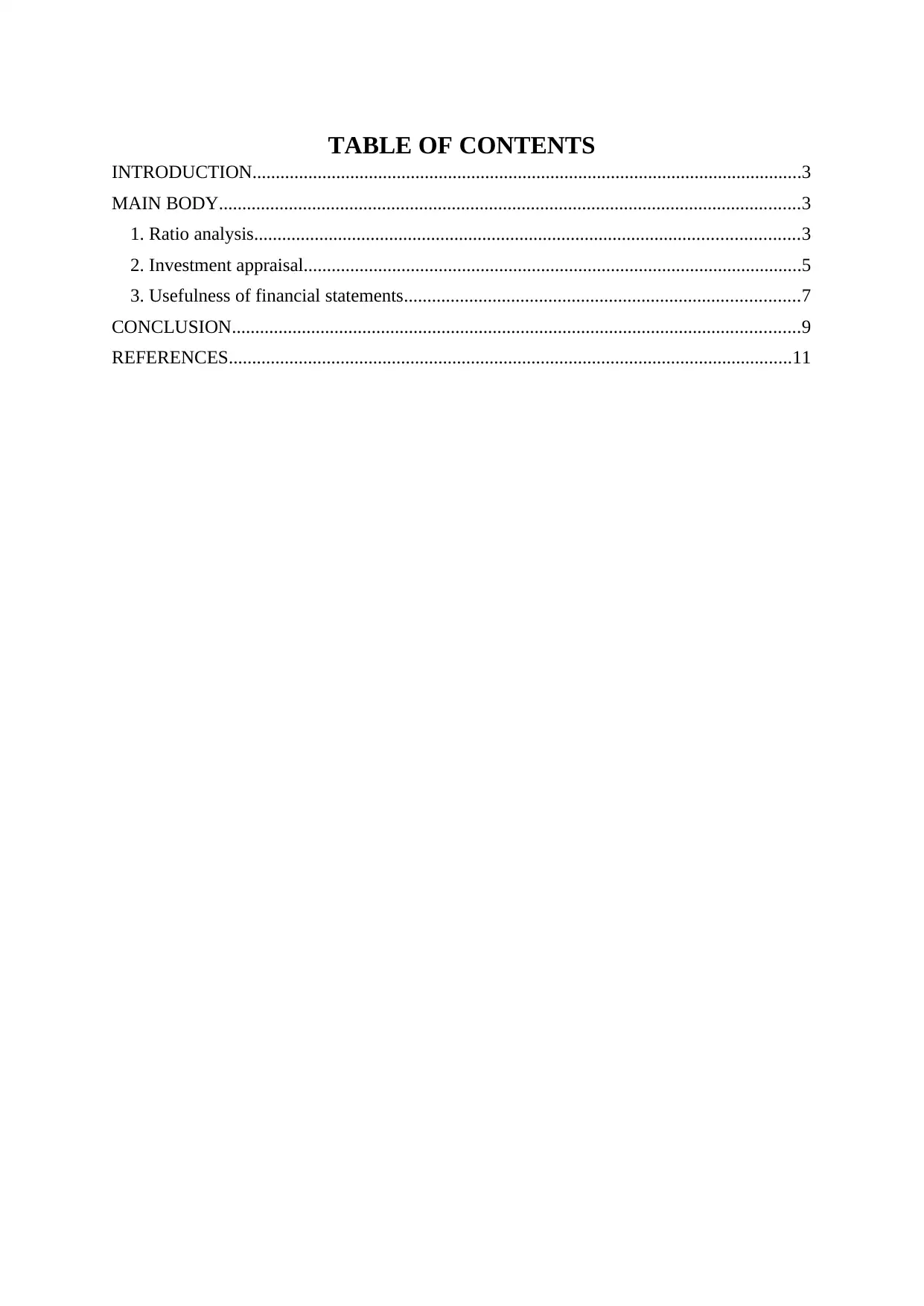
TABLE OF CONTENTS
INTRODUCTION......................................................................................................................3
MAIN BODY.............................................................................................................................3
1. Ratio analysis.....................................................................................................................3
2. Investment appraisal...........................................................................................................5
3. Usefulness of financial statements.....................................................................................7
CONCLUSION..........................................................................................................................9
REFERENCES.........................................................................................................................11
INTRODUCTION......................................................................................................................3
MAIN BODY.............................................................................................................................3
1. Ratio analysis.....................................................................................................................3
2. Investment appraisal...........................................................................................................5
3. Usefulness of financial statements.....................................................................................7
CONCLUSION..........................................................................................................................9
REFERENCES.........................................................................................................................11
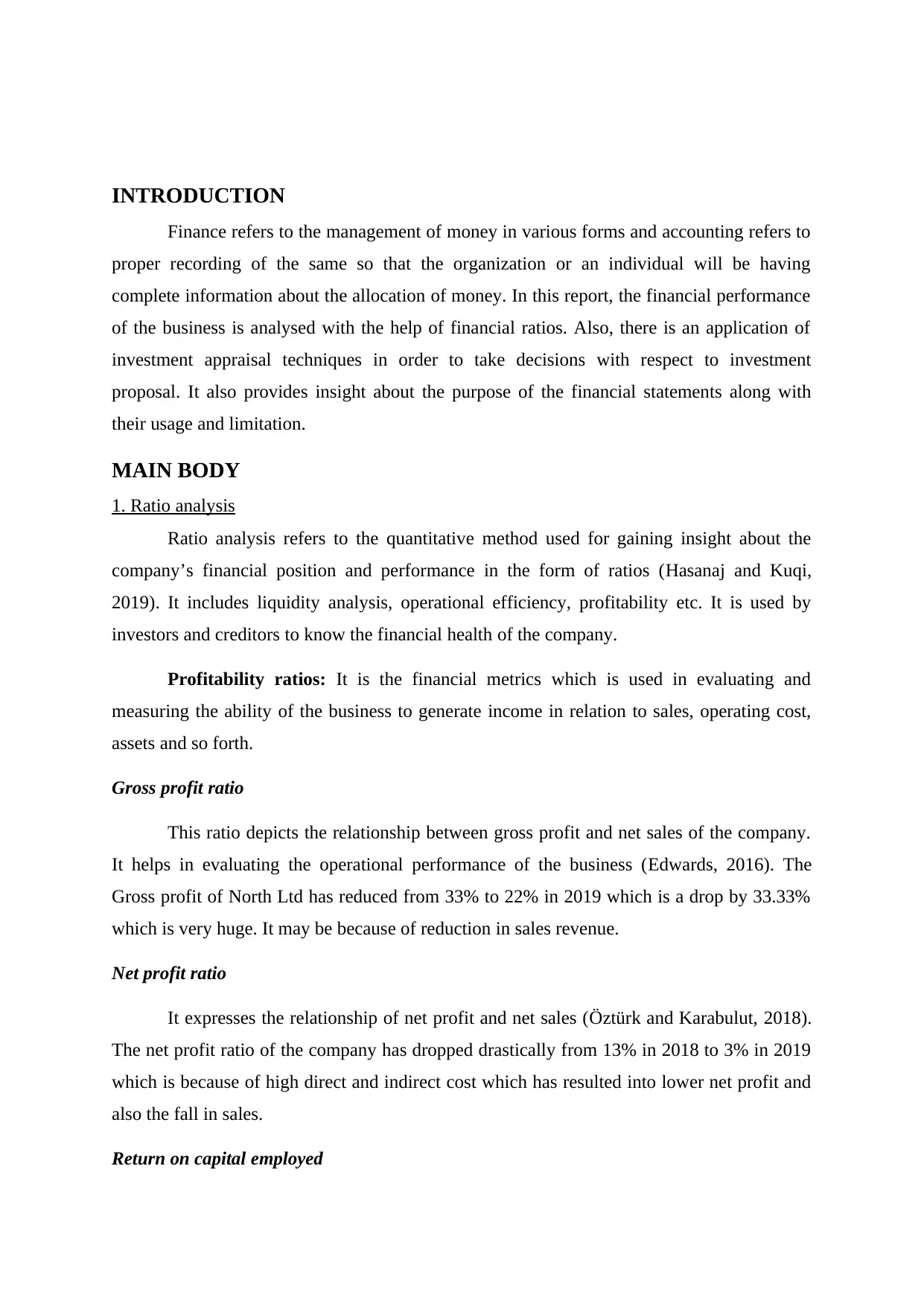
INTRODUCTION
Finance refers to the management of money in various forms and accounting refers to
proper recording of the same so that the organization or an individual will be having
complete information about the allocation of money. In this report, the financial performance
of the business is analysed with the help of financial ratios. Also, there is an application of
investment appraisal techniques in order to take decisions with respect to investment
proposal. It also provides insight about the purpose of the financial statements along with
their usage and limitation.
MAIN BODY
1. Ratio analysis
Ratio analysis refers to the quantitative method used for gaining insight about the
company’s financial position and performance in the form of ratios (Hasanaj and Kuqi,
2019). It includes liquidity analysis, operational efficiency, profitability etc. It is used by
investors and creditors to know the financial health of the company.
Profitability ratios: It is the financial metrics which is used in evaluating and
measuring the ability of the business to generate income in relation to sales, operating cost,
assets and so forth.
Gross profit ratio
This ratio depicts the relationship between gross profit and net sales of the company.
It helps in evaluating the operational performance of the business (Edwards, 2016). The
Gross profit of North Ltd has reduced from 33% to 22% in 2019 which is a drop by 33.33%
which is very huge. It may be because of reduction in sales revenue.
Net profit ratio
It expresses the relationship of net profit and net sales (Öztürk and Karabulut, 2018).
The net profit ratio of the company has dropped drastically from 13% in 2018 to 3% in 2019
which is because of high direct and indirect cost which has resulted into lower net profit and
also the fall in sales.
Return on capital employed
Finance refers to the management of money in various forms and accounting refers to
proper recording of the same so that the organization or an individual will be having
complete information about the allocation of money. In this report, the financial performance
of the business is analysed with the help of financial ratios. Also, there is an application of
investment appraisal techniques in order to take decisions with respect to investment
proposal. It also provides insight about the purpose of the financial statements along with
their usage and limitation.
MAIN BODY
1. Ratio analysis
Ratio analysis refers to the quantitative method used for gaining insight about the
company’s financial position and performance in the form of ratios (Hasanaj and Kuqi,
2019). It includes liquidity analysis, operational efficiency, profitability etc. It is used by
investors and creditors to know the financial health of the company.
Profitability ratios: It is the financial metrics which is used in evaluating and
measuring the ability of the business to generate income in relation to sales, operating cost,
assets and so forth.
Gross profit ratio
This ratio depicts the relationship between gross profit and net sales of the company.
It helps in evaluating the operational performance of the business (Edwards, 2016). The
Gross profit of North Ltd has reduced from 33% to 22% in 2019 which is a drop by 33.33%
which is very huge. It may be because of reduction in sales revenue.
Net profit ratio
It expresses the relationship of net profit and net sales (Öztürk and Karabulut, 2018).
The net profit ratio of the company has dropped drastically from 13% in 2018 to 3% in 2019
which is because of high direct and indirect cost which has resulted into lower net profit and
also the fall in sales.
Return on capital employed

This ratio measures the efficiency of the business in generating profit from the capital
employed. It helps in analysing the long-term profitability and longevity of the business. The
return on capital employed of North Ltd has shown a sign of reduction to 11% in 2019 as
compared to 40% in 2018. This means that the company is not effective in utilizing its capital
employed.
Profitability ratios
Name Formula Working
2018
Working
2019
Result
2018
Result
2019
Gross profit
ratio
Gross profit/ net
sales
3500/10700 2050/9500 33% 22%
Net profit
ratio
Net profit/ net
sales
1400/10700 300/9500 13% 3%
Return on
capital
employed
Net operating
profit/Employed
Capital
1400/3500 300/2800 40% 11%
Liquidity ratios: These are the ratios which are used to measure the ability of the
business to pay off its short-term obligations.
Current ratio
This ratio is used in measuring the liquidity position of the company. It helps in
analysing whether the company is having enough cash to meet its short-term liabilities. It is
the most popular ratio for measuring the liquidity of the business (Hasanaj and Kuqi, 2019).
In case of North Ltd, the current ratio the company is high even though it has reduced from
3.38 times to 3.10 times in 2019. It means that the company is having enough liquid assets
but it may also mean that the lot of cash is blocked in its debtors and having recovering issues
which has caused rise in current ratio. Also, too much amount is invested in the inventory can
be reason for rise in current asset.
Quick ratio
It measures the liquidity but in a more conservative manner as it does not consider
inventory and prepaid expenses (Linares-Mustarós, Coenders and Vives-Mestres, 2018). The
employed. It helps in analysing the long-term profitability and longevity of the business. The
return on capital employed of North Ltd has shown a sign of reduction to 11% in 2019 as
compared to 40% in 2018. This means that the company is not effective in utilizing its capital
employed.
Profitability ratios
Name Formula Working
2018
Working
2019
Result
2018
Result
2019
Gross profit
ratio
Gross profit/ net
sales
3500/10700 2050/9500 33% 22%
Net profit
ratio
Net profit/ net
sales
1400/10700 300/9500 13% 3%
Return on
capital
employed
Net operating
profit/Employed
Capital
1400/3500 300/2800 40% 11%
Liquidity ratios: These are the ratios which are used to measure the ability of the
business to pay off its short-term obligations.
Current ratio
This ratio is used in measuring the liquidity position of the company. It helps in
analysing whether the company is having enough cash to meet its short-term liabilities. It is
the most popular ratio for measuring the liquidity of the business (Hasanaj and Kuqi, 2019).
In case of North Ltd, the current ratio the company is high even though it has reduced from
3.38 times to 3.10 times in 2019. It means that the company is having enough liquid assets
but it may also mean that the lot of cash is blocked in its debtors and having recovering issues
which has caused rise in current ratio. Also, too much amount is invested in the inventory can
be reason for rise in current asset.
Quick ratio
It measures the liquidity but in a more conservative manner as it does not consider
inventory and prepaid expenses (Linares-Mustarós, Coenders and Vives-Mestres, 2018). The
Secure Best Marks with AI Grader
Need help grading? Try our AI Grader for instant feedback on your assignments.
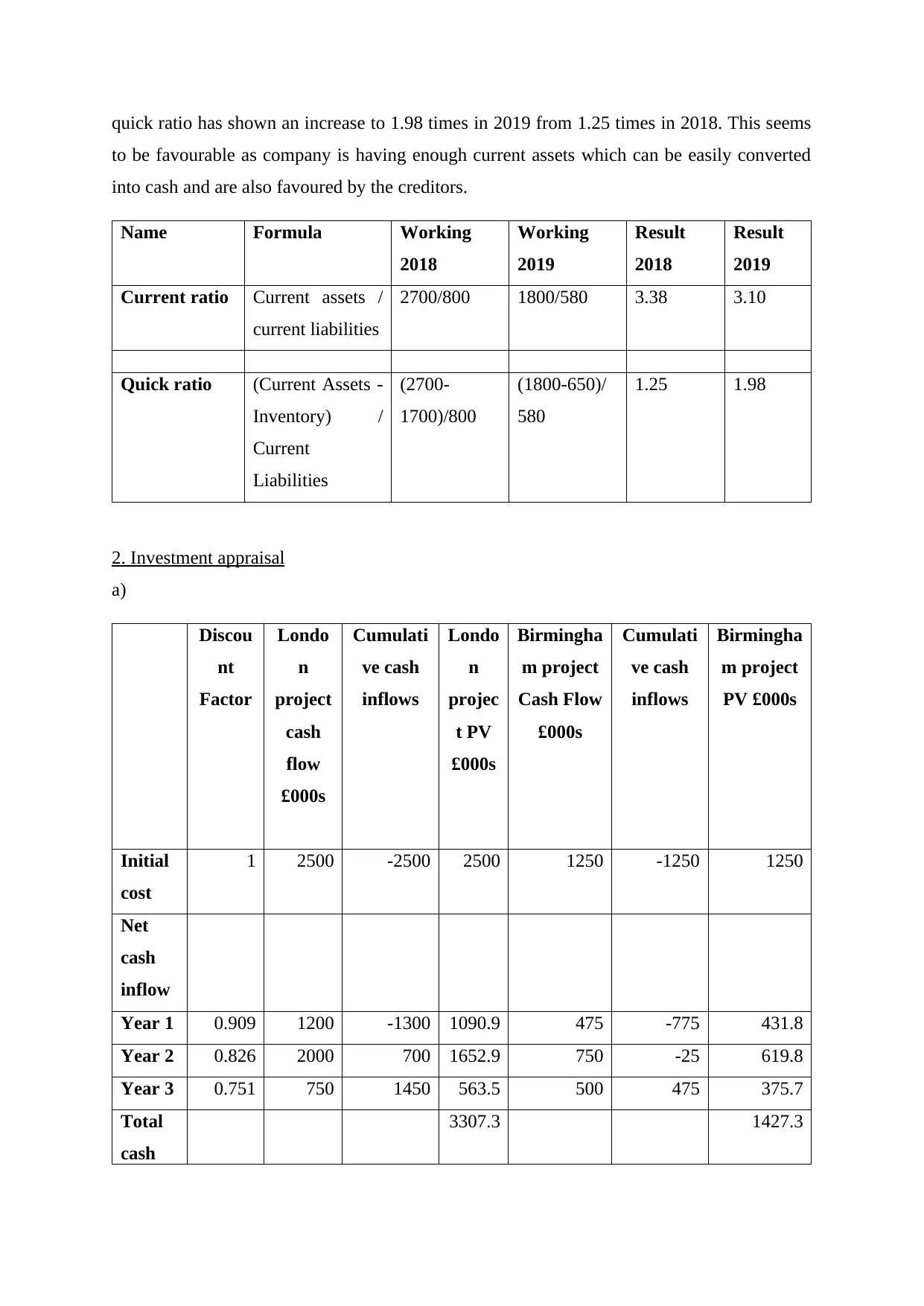
quick ratio has shown an increase to 1.98 times in 2019 from 1.25 times in 2018. This seems
to be favourable as company is having enough current assets which can be easily converted
into cash and are also favoured by the creditors.
Name Formula Working
2018
Working
2019
Result
2018
Result
2019
Current ratio Current assets /
current liabilities
2700/800 1800/580 3.38 3.10
Quick ratio (Current Assets -
Inventory) /
Current
Liabilities
(2700-
1700)/800
(1800-650)/
580
1.25 1.98
2. Investment appraisal
a)
Discou
nt
Factor
Londo
n
project
cash
flow
£000s
Cumulati
ve cash
inflows
Londo
n
projec
t PV
£000s
Birmingha
m project
Cash Flow
£000s
Cumulati
ve cash
inflows
Birmingha
m project
PV £000s
Initial
cost
1 2500 -2500 2500 1250 -1250 1250
Net
cash
inflow
Year 1 0.909 1200 -1300 1090.9 475 -775 431.8
Year 2 0.826 2000 700 1652.9 750 -25 619.8
Year 3 0.751 750 1450 563.5 500 475 375.7
Total
cash
3307.3 1427.3
to be favourable as company is having enough current assets which can be easily converted
into cash and are also favoured by the creditors.
Name Formula Working
2018
Working
2019
Result
2018
Result
2019
Current ratio Current assets /
current liabilities
2700/800 1800/580 3.38 3.10
Quick ratio (Current Assets -
Inventory) /
Current
Liabilities
(2700-
1700)/800
(1800-650)/
580
1.25 1.98
2. Investment appraisal
a)
Discou
nt
Factor
Londo
n
project
cash
flow
£000s
Cumulati
ve cash
inflows
Londo
n
projec
t PV
£000s
Birmingha
m project
Cash Flow
£000s
Cumulati
ve cash
inflows
Birmingha
m project
PV £000s
Initial
cost
1 2500 -2500 2500 1250 -1250 1250
Net
cash
inflow
Year 1 0.909 1200 -1300 1090.9 475 -775 431.8
Year 2 0.826 2000 700 1652.9 750 -25 619.8
Year 3 0.751 750 1450 563.5 500 475 375.7
Total
cash
3307.3 1427.3

inflow
NPV 807.3 177.3
Paybac
k
period
1.7 2.1
Averag
e cash
inflow
1316.7 575.0
Averag
e Rate
of
Return
53% 46%
b)
Based on the various investment appraisal techniques applied on both the projects it can be
said that it is better for the ATOB Limited to invest in the London project in comparison to
the Birmingham project (Häcker and Ernst, 2017). The net present value of London project is
much more than Birmingham and also the payback period is 1.7 years in contrast to 2.1 years
in other one. The average rate of return is higher in the former one which is 53% instead of
46% in Birmingham project (Sinha and Datta, 2020). Thus, in all respect London is project is
more profitable to the company.
c)
Although, financial factors are very important for making vital decision in respect to
investment but non-financial factors are also very important (Investment appraisal
techniques. 2020). The key non-financial factors to be considered while making investment
decisions are given below.
Meeting the requirements of the both current and future legislation.
Matching it with the industry standards and implementing good practice.
Maintaining and establishing the good and cordial relationship with the suppliers and
the customers.
NPV 807.3 177.3
Paybac
k
period
1.7 2.1
Averag
e cash
inflow
1316.7 575.0
Averag
e Rate
of
Return
53% 46%
b)
Based on the various investment appraisal techniques applied on both the projects it can be
said that it is better for the ATOB Limited to invest in the London project in comparison to
the Birmingham project (Häcker and Ernst, 2017). The net present value of London project is
much more than Birmingham and also the payback period is 1.7 years in contrast to 2.1 years
in other one. The average rate of return is higher in the former one which is 53% instead of
46% in Birmingham project (Sinha and Datta, 2020). Thus, in all respect London is project is
more profitable to the company.
c)
Although, financial factors are very important for making vital decision in respect to
investment but non-financial factors are also very important (Investment appraisal
techniques. 2020). The key non-financial factors to be considered while making investment
decisions are given below.
Meeting the requirements of the both current and future legislation.
Matching it with the industry standards and implementing good practice.
Maintaining and establishing the good and cordial relationship with the suppliers and
the customers.

Improving and enhancing the relationship with the local community along with the
improving the reputation of the business (Taheri, Shafiee and Evazzadeh Fath, 2019).
Anticipating any future change in the economic and market condition which will
affect the business.
Dealing with the uncertain events such as protecting the intellectual property with
respect to the potential competition.
Staff morale is essential which helps in recruiting and retaining the employees.
For example, a company may not invest in the project of acquiring a new machinery if it
breaks health and safety regulations. Thus, these factors are very important to be taken
into account while making decisions between the two projects.
3. Usefulness of financial statements
a)
The financial statements of the company is a formal document which reflects the true
and fair picture of the company’s financial position and performance. It not states about the
profit or loss but also about the asset and liabilities of the company. It presents the financial
information of the business which are used by the external parties or user’s such as creditors,
investors, government authorities, customers etc. there are three main financial statements
which are balance sheet, profit and loss account and cash flow statement.
The financial statements are prepared with respect to the financial events and are
recorded in the chronological manner (Richards, 2019). Then, it goes through processes as
per the statutory requirement and then finally financial statements is prepared. The nature of
financial statement depends upon the following points which are stated below.
Recorded facts: First the data is recorded in the monetary terms in order to prepare
the financial statements.
Accounting conventions: Accounting standards along with certain conventions are
required to be applied while preparing the financial statements. For example, inventory
valuation at cost or market price whichever is lower.
Postulates: These are presumptions which are made while doing accounting. For
example, following the Generally Accepted Accounting Principles.
improving the reputation of the business (Taheri, Shafiee and Evazzadeh Fath, 2019).
Anticipating any future change in the economic and market condition which will
affect the business.
Dealing with the uncertain events such as protecting the intellectual property with
respect to the potential competition.
Staff morale is essential which helps in recruiting and retaining the employees.
For example, a company may not invest in the project of acquiring a new machinery if it
breaks health and safety regulations. Thus, these factors are very important to be taken
into account while making decisions between the two projects.
3. Usefulness of financial statements
a)
The financial statements of the company is a formal document which reflects the true
and fair picture of the company’s financial position and performance. It not states about the
profit or loss but also about the asset and liabilities of the company. It presents the financial
information of the business which are used by the external parties or user’s such as creditors,
investors, government authorities, customers etc. there are three main financial statements
which are balance sheet, profit and loss account and cash flow statement.
The financial statements are prepared with respect to the financial events and are
recorded in the chronological manner (Richards, 2019). Then, it goes through processes as
per the statutory requirement and then finally financial statements is prepared. The nature of
financial statement depends upon the following points which are stated below.
Recorded facts: First the data is recorded in the monetary terms in order to prepare
the financial statements.
Accounting conventions: Accounting standards along with certain conventions are
required to be applied while preparing the financial statements. For example, inventory
valuation at cost or market price whichever is lower.
Postulates: These are presumptions which are made while doing accounting. For
example, following the Generally Accepted Accounting Principles.
Paraphrase This Document
Need a fresh take? Get an instant paraphrase of this document with our AI Paraphraser

Personal judgements: The each and every personal judgement plays an important
role while preparing financial statements.
Purpose of financial statements
The three financial statements are the income statement, balance sheet and cash flow
statements.
The income statement states about the profitability of the company. It starts with
revenue, which is subtracted to various expenses incurred in order to arrive at the net
income (Osadchy and et.al, 2018). It covers specific period, mainly a year. It helps in
analysing the expenses incurred with respect to sales.
The balance sheet does not account for the entire period but is a snapshot of the
company at a point of time. It depicts the company’s resources in terms assets and on
the other side, it shows the sources of funding those resources, which are the liabilities
and shareholder’s equity. It helps in knowing the amount of current asset and fixed
asset it has with respect to the liabilities. This used in calculating various financial
ratios.
The last is the cash flow statements, which is a magnification of the cash account
which is shown in the balance sheet. It states about the different sources of cash flow.
It starts from the net incomes and adjusts all the non-cash expenses and incomes. It
helps in identifying the cash flow from various activities such from business
operations, investing activities and financing activities.
b)
The statement of position or balance sheet provides the details about the company
financial status at any specific point of time to its users. It is one of the sources of information
for the users for taking valuable decisions. It provides an insight about the ability of the
business from the long-term perspective.
Uses of balance sheet
The management of the company can get details about the capital structure of the
company with respect to the sources of funding.
It also helps in knowing the liquidity position of the company by determining the
amount of current assets it has to pay off its current liabilities (The Benefits of Using a
role while preparing financial statements.
Purpose of financial statements
The three financial statements are the income statement, balance sheet and cash flow
statements.
The income statement states about the profitability of the company. It starts with
revenue, which is subtracted to various expenses incurred in order to arrive at the net
income (Osadchy and et.al, 2018). It covers specific period, mainly a year. It helps in
analysing the expenses incurred with respect to sales.
The balance sheet does not account for the entire period but is a snapshot of the
company at a point of time. It depicts the company’s resources in terms assets and on
the other side, it shows the sources of funding those resources, which are the liabilities
and shareholder’s equity. It helps in knowing the amount of current asset and fixed
asset it has with respect to the liabilities. This used in calculating various financial
ratios.
The last is the cash flow statements, which is a magnification of the cash account
which is shown in the balance sheet. It states about the different sources of cash flow.
It starts from the net incomes and adjusts all the non-cash expenses and incomes. It
helps in identifying the cash flow from various activities such from business
operations, investing activities and financing activities.
b)
The statement of position or balance sheet provides the details about the company
financial status at any specific point of time to its users. It is one of the sources of information
for the users for taking valuable decisions. It provides an insight about the ability of the
business from the long-term perspective.
Uses of balance sheet
The management of the company can get details about the capital structure of the
company with respect to the sources of funding.
It also helps in knowing the liquidity position of the company by determining the
amount of current assets it has to pay off its current liabilities (The Benefits of Using a
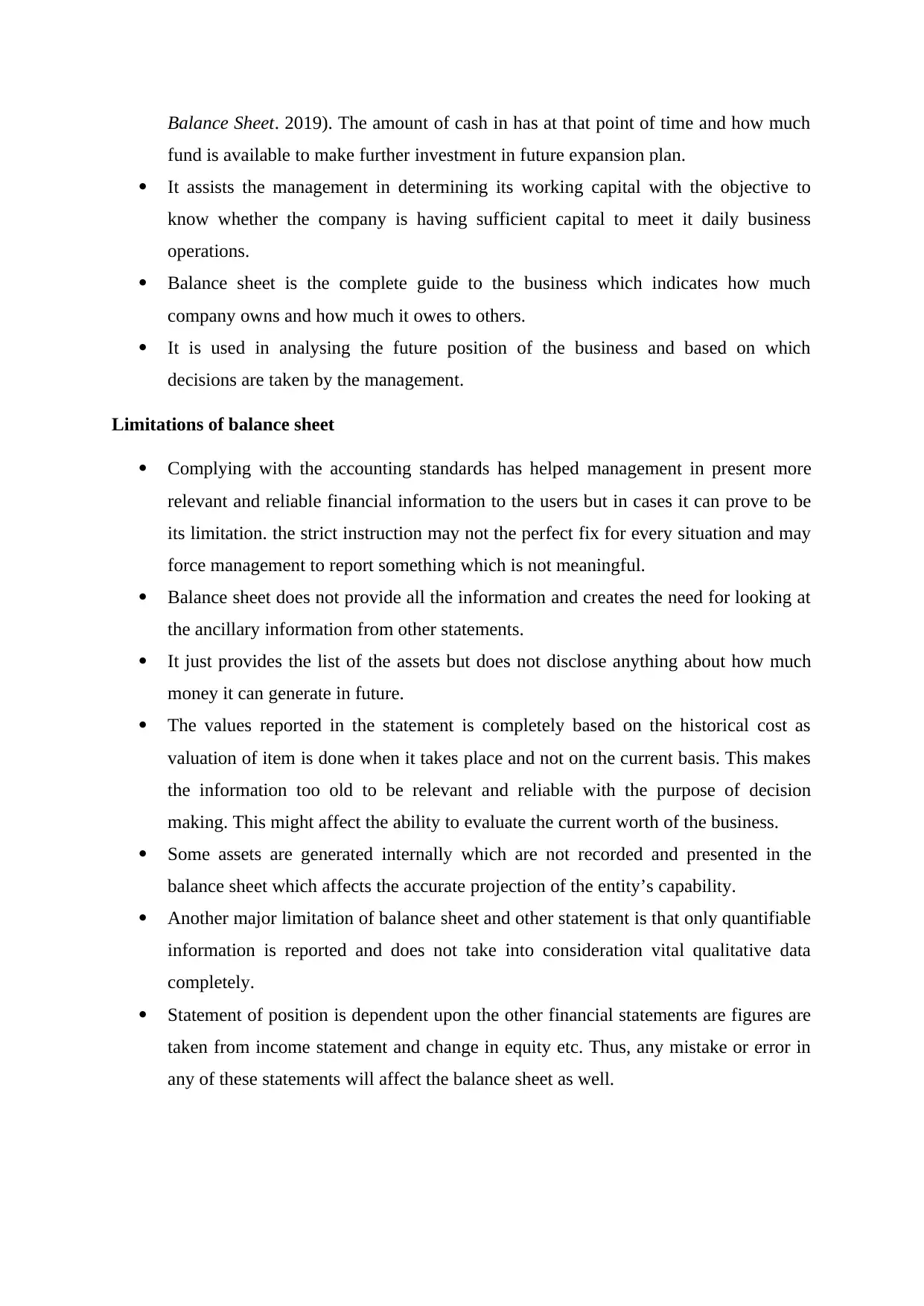
Balance Sheet. 2019). The amount of cash in has at that point of time and how much
fund is available to make further investment in future expansion plan.
It assists the management in determining its working capital with the objective to
know whether the company is having sufficient capital to meet it daily business
operations.
Balance sheet is the complete guide to the business which indicates how much
company owns and how much it owes to others.
It is used in analysing the future position of the business and based on which
decisions are taken by the management.
Limitations of balance sheet
Complying with the accounting standards has helped management in present more
relevant and reliable financial information to the users but in cases it can prove to be
its limitation. the strict instruction may not the perfect fix for every situation and may
force management to report something which is not meaningful.
Balance sheet does not provide all the information and creates the need for looking at
the ancillary information from other statements.
It just provides the list of the assets but does not disclose anything about how much
money it can generate in future.
The values reported in the statement is completely based on the historical cost as
valuation of item is done when it takes place and not on the current basis. This makes
the information too old to be relevant and reliable with the purpose of decision
making. This might affect the ability to evaluate the current worth of the business.
Some assets are generated internally which are not recorded and presented in the
balance sheet which affects the accurate projection of the entity’s capability.
Another major limitation of balance sheet and other statement is that only quantifiable
information is reported and does not take into consideration vital qualitative data
completely.
Statement of position is dependent upon the other financial statements are figures are
taken from income statement and change in equity etc. Thus, any mistake or error in
any of these statements will affect the balance sheet as well.
fund is available to make further investment in future expansion plan.
It assists the management in determining its working capital with the objective to
know whether the company is having sufficient capital to meet it daily business
operations.
Balance sheet is the complete guide to the business which indicates how much
company owns and how much it owes to others.
It is used in analysing the future position of the business and based on which
decisions are taken by the management.
Limitations of balance sheet
Complying with the accounting standards has helped management in present more
relevant and reliable financial information to the users but in cases it can prove to be
its limitation. the strict instruction may not the perfect fix for every situation and may
force management to report something which is not meaningful.
Balance sheet does not provide all the information and creates the need for looking at
the ancillary information from other statements.
It just provides the list of the assets but does not disclose anything about how much
money it can generate in future.
The values reported in the statement is completely based on the historical cost as
valuation of item is done when it takes place and not on the current basis. This makes
the information too old to be relevant and reliable with the purpose of decision
making. This might affect the ability to evaluate the current worth of the business.
Some assets are generated internally which are not recorded and presented in the
balance sheet which affects the accurate projection of the entity’s capability.
Another major limitation of balance sheet and other statement is that only quantifiable
information is reported and does not take into consideration vital qualitative data
completely.
Statement of position is dependent upon the other financial statements are figures are
taken from income statement and change in equity etc. Thus, any mistake or error in
any of these statements will affect the balance sheet as well.
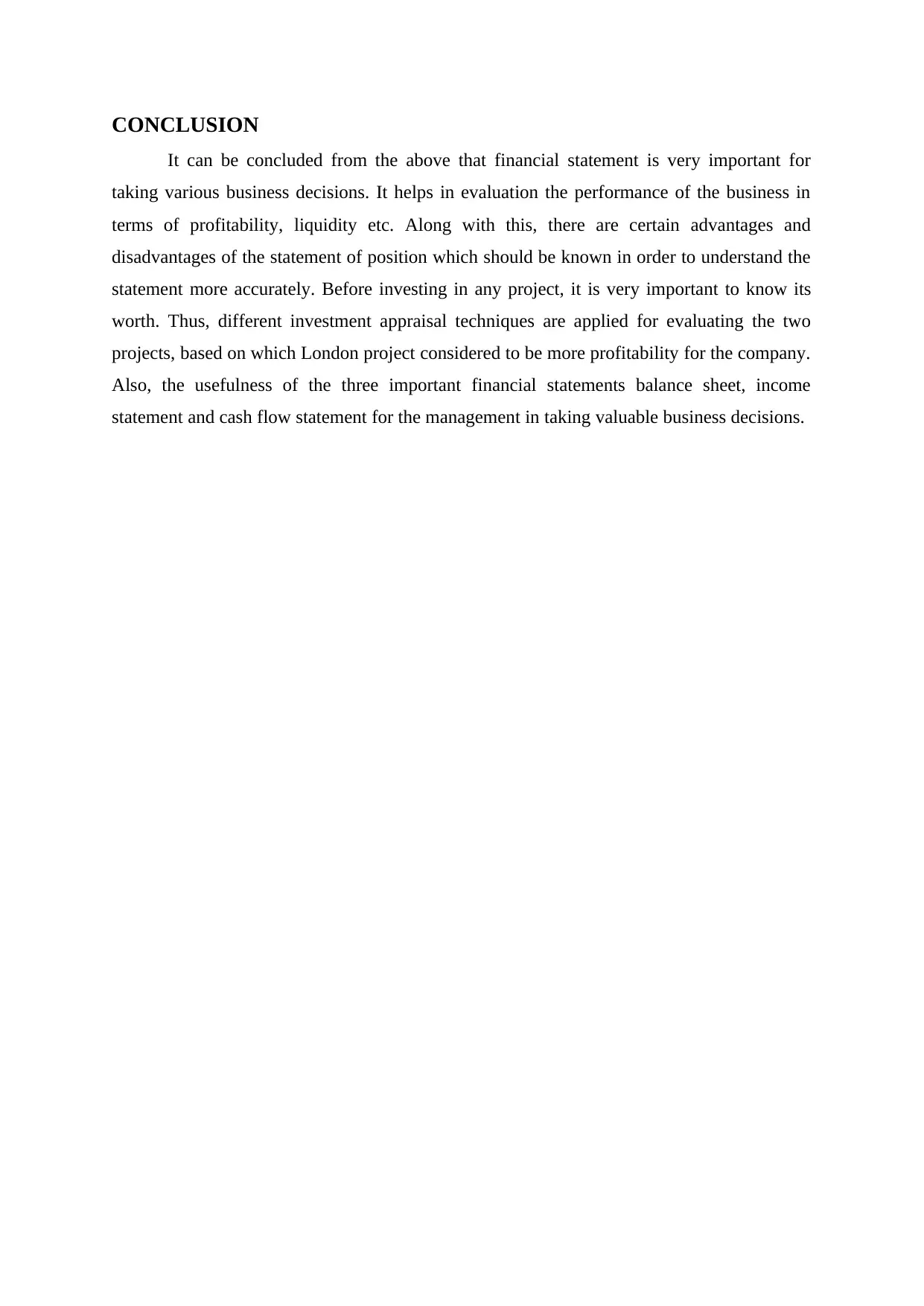
CONCLUSION
It can be concluded from the above that financial statement is very important for
taking various business decisions. It helps in evaluation the performance of the business in
terms of profitability, liquidity etc. Along with this, there are certain advantages and
disadvantages of the statement of position which should be known in order to understand the
statement more accurately. Before investing in any project, it is very important to know its
worth. Thus, different investment appraisal techniques are applied for evaluating the two
projects, based on which London project considered to be more profitability for the company.
Also, the usefulness of the three important financial statements balance sheet, income
statement and cash flow statement for the management in taking valuable business decisions.
It can be concluded from the above that financial statement is very important for
taking various business decisions. It helps in evaluation the performance of the business in
terms of profitability, liquidity etc. Along with this, there are certain advantages and
disadvantages of the statement of position which should be known in order to understand the
statement more accurately. Before investing in any project, it is very important to know its
worth. Thus, different investment appraisal techniques are applied for evaluating the two
projects, based on which London project considered to be more profitability for the company.
Also, the usefulness of the three important financial statements balance sheet, income
statement and cash flow statement for the management in taking valuable business decisions.
Secure Best Marks with AI Grader
Need help grading? Try our AI Grader for instant feedback on your assignments.
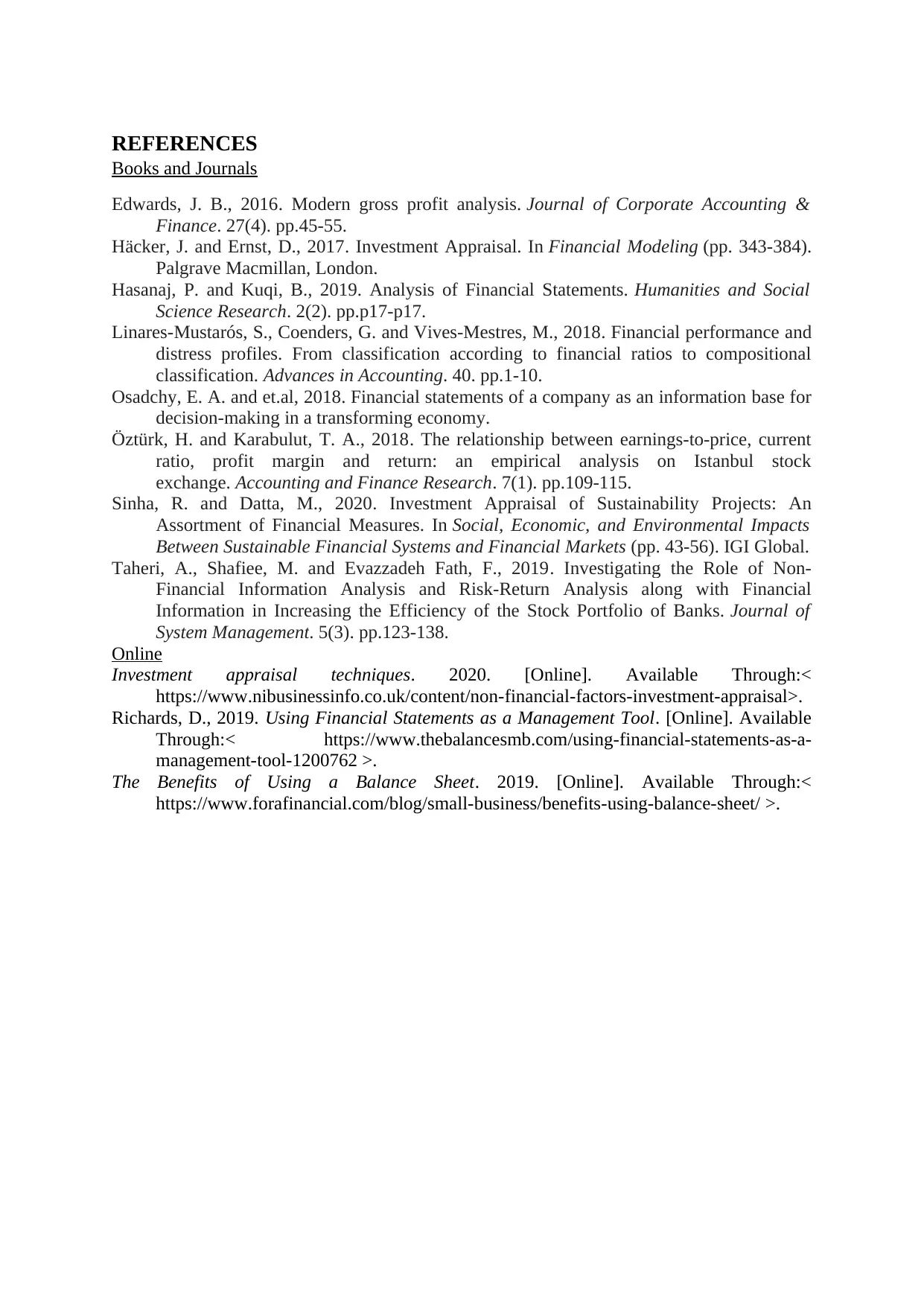
REFERENCES
Books and Journals
Edwards, J. B., 2016. Modern gross profit analysis. Journal of Corporate Accounting &
Finance. 27(4). pp.45-55.
Häcker, J. and Ernst, D., 2017. Investment Appraisal. In Financial Modeling (pp. 343-384).
Palgrave Macmillan, London.
Hasanaj, P. and Kuqi, B., 2019. Analysis of Financial Statements. Humanities and Social
Science Research. 2(2). pp.p17-p17.
Linares-Mustarós, S., Coenders, G. and Vives-Mestres, M., 2018. Financial performance and
distress profiles. From classification according to financial ratios to compositional
classification. Advances in Accounting. 40. pp.1-10.
Osadchy, E. A. and et.al, 2018. Financial statements of a company as an information base for
decision-making in a transforming economy.
Öztürk, H. and Karabulut, T. A., 2018. The relationship between earnings-to-price, current
ratio, profit margin and return: an empirical analysis on Istanbul stock
exchange. Accounting and Finance Research. 7(1). pp.109-115.
Sinha, R. and Datta, M., 2020. Investment Appraisal of Sustainability Projects: An
Assortment of Financial Measures. In Social, Economic, and Environmental Impacts
Between Sustainable Financial Systems and Financial Markets (pp. 43-56). IGI Global.
Taheri, A., Shafiee, M. and Evazzadeh Fath, F., 2019. Investigating the Role of Non-
Financial Information Analysis and Risk-Return Analysis along with Financial
Information in Increasing the Efficiency of the Stock Portfolio of Banks. Journal of
System Management. 5(3). pp.123-138.
Online
Investment appraisal techniques. 2020. [Online]. Available Through:<
https://www.nibusinessinfo.co.uk/content/non-financial-factors-investment-appraisal>.
Richards, D., 2019. Using Financial Statements as a Management Tool. [Online]. Available
Through:< https://www.thebalancesmb.com/using-financial-statements-as-a-
management-tool-1200762 >.
The Benefits of Using a Balance Sheet. 2019. [Online]. Available Through:<
https://www.forafinancial.com/blog/small-business/benefits-using-balance-sheet/ >.
Books and Journals
Edwards, J. B., 2016. Modern gross profit analysis. Journal of Corporate Accounting &
Finance. 27(4). pp.45-55.
Häcker, J. and Ernst, D., 2017. Investment Appraisal. In Financial Modeling (pp. 343-384).
Palgrave Macmillan, London.
Hasanaj, P. and Kuqi, B., 2019. Analysis of Financial Statements. Humanities and Social
Science Research. 2(2). pp.p17-p17.
Linares-Mustarós, S., Coenders, G. and Vives-Mestres, M., 2018. Financial performance and
distress profiles. From classification according to financial ratios to compositional
classification. Advances in Accounting. 40. pp.1-10.
Osadchy, E. A. and et.al, 2018. Financial statements of a company as an information base for
decision-making in a transforming economy.
Öztürk, H. and Karabulut, T. A., 2018. The relationship between earnings-to-price, current
ratio, profit margin and return: an empirical analysis on Istanbul stock
exchange. Accounting and Finance Research. 7(1). pp.109-115.
Sinha, R. and Datta, M., 2020. Investment Appraisal of Sustainability Projects: An
Assortment of Financial Measures. In Social, Economic, and Environmental Impacts
Between Sustainable Financial Systems and Financial Markets (pp. 43-56). IGI Global.
Taheri, A., Shafiee, M. and Evazzadeh Fath, F., 2019. Investigating the Role of Non-
Financial Information Analysis and Risk-Return Analysis along with Financial
Information in Increasing the Efficiency of the Stock Portfolio of Banks. Journal of
System Management. 5(3). pp.123-138.
Online
Investment appraisal techniques. 2020. [Online]. Available Through:<
https://www.nibusinessinfo.co.uk/content/non-financial-factors-investment-appraisal>.
Richards, D., 2019. Using Financial Statements as a Management Tool. [Online]. Available
Through:< https://www.thebalancesmb.com/using-financial-statements-as-a-
management-tool-1200762 >.
The Benefits of Using a Balance Sheet. 2019. [Online]. Available Through:<
https://www.forafinancial.com/blog/small-business/benefits-using-balance-sheet/ >.
1 out of 11
Related Documents
Your All-in-One AI-Powered Toolkit for Academic Success.
+13062052269
info@desklib.com
Available 24*7 on WhatsApp / Email
![[object Object]](/_next/static/media/star-bottom.7253800d.svg)
Unlock your academic potential
© 2024 | Zucol Services PVT LTD | All rights reserved.





